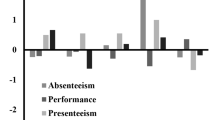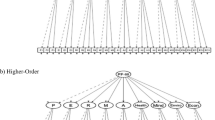Abstract
This article reports on the development and preliminary empirical testing of two new scales designed to assess workaholic behavioral patterns. One scale assessed employee tendencies to perform nonrequired work (typically, spending time thinking of ways to perform work better), and the other measured tendencies to intrude on and attempt to control the work of others. These scales seem consistent with both conceptual definitions and anecdotal accounts of workaholism. Moreover, the scales were designed to assess behavioral tendencies rather than work attitudes, to circumvent the possibility of rationalization and denial among workaholic respondents, and to be applicable across multiple work contexts. Evidence from a sample of 278 employed respondents indicated that the scales were internally consistent, and represented distinct constructs. The scales also demonstrated evidence of convergent and discriminant validity. For example, scores on the nonrequired work scale correlated positively with hours worked and with the needs for achievement, autonomy, and affiliation. Scores on the control of others scale correlated positively with job involvement, stress, work-nonwork conflict, role conflict, dominance needs, and self-monitoring. In summary, the workaholism scales developed for this investigation appear both reliable and valid and thus potentially able to shed light on the phenomenon of workaholism.
Similar content being viewed by others
REFERENCES
Akaike, H. (1987). Factor analysis and AIC. Psychometrika, 52, 317-332.
Baechler, M. (1996). I'm Mary, and I'm a workaholic. Inc., 18(5), 29-30.
Bentler, P. M., & Bonett, D. G. (1980). Significance tests and goodness of fit in the analysis of covariance structures. Psychological Bulletin, 88, 588-606.
Bollen, K. A. (1989). A new incremental fit index for general structural equation models. Sociological Methods and Research, 17, 303-316.
Briggs, S. R., & Cheek, J. M. (1986). The role of factor analysis in the development and evaluation of personality scales. Journal of Personality, 54, 106-148.
Browne, M. W., & Cudeck, R. (1993). Alternative ways of assessing model fit. In K. A. Bollen & J. S. Long (Eds.), Testing structural equation models (pp. 136-162). Newbury Park, CA: Sage.
Burke, R. J. (1999a). It's not how hard you work but how you work hard: Evaluating workaholism components. International Journal of Stress Management, 6, 225-239.
Burke, R. J. (1999b). Workaholism in organizations: Measurement validation and replication. International Journal of Stress Management, 6, 45-55.
Burke, R. J. (2000). Workaholism in organizations: Psychological and physical well-being consequences. Stress Medicine, 16, 11-16.
Cohen, A. (1995). An examination of the relationships between work commitment and nonwork domains. Human Relations, 48, 239-263.
Cohen, A. (1999). The relation between commitment forms and work outcomes in Jewish and Arab culture. Human Relations, 54, 371-391.
Costello, J. (2000). Full-time dilemma: Economy bedevils workaholics group. Wall Street Journal, February 8, p. A1.
Ettington, D. R. (1998). Successful career plateauing. Journal of Vocational Behavior, 52, 72-88.
Furnham, A., Brewin, C. R., & O'Kelly, H. (1994). Cognitive style and attitudes to work. Human Relations, 47, 1509-1521.
Gini, A. (1998). Working ourselves to death: Workaholism, stress, and fatigue. Business and Society Review, 100-101, 45-46.
Hackman, J. R., & Lawler, E. E. III. (1971). Employee reactions to job characteristics. Journal of Applied Psychology, 55, 259-286.
Hoffi-Hofstetter, H., & Mannheim, B. (1999). Managers' coping resources, perceived organizational patterns, and responses during organizational recovery from decline. Journal of Organizational Behavior, 20, 665-685.
Jackson, D. N. (1984). Personality Research Form manual (3rd ed.). Port Huron, MI: Research Psychologists Press.
Jöreskog, K. G., & Sörbom, D. (1986). LISREL VI: Analysis of linear structural relationships by maximum likelihood and least squares methods. Mooresville, IN: Scientific Software, Inc.
Jöreskog, K. G., & Sörbom, D. (1996). LISREL 8: User's Reference Guide (2nd ed.). Chicago: Scientific Software.
Kanungo, R. N. (1982). Measurement of job and work involvement. Journal of Applied Psychology, 67, 341-349.
Kopelman, R. E., Greenhaus, J. H., & Connolly, T. F. (1983). A model of work, family and interrole conflict: A construct validation study. Organizational Behavior and Human Performance, 32, 198-215.
Lynn, M., & Simons, T. (2000). Predictors of male and female servers' average tip earnings. Journal of Applied Social Psychology, 30, 241-252.
Machlowitz, M. (1980). Workaholics: Living with them, working with them. Reading, MA: Addison-Wesley.
Mannheim, B., Baruch, Y., & Tal, J. (1997). Alternative models for antecedents and outcomes of work centrality and job satisfaction of high-tech personnel. Human Relations, 50, 1537-1562.
Moorman, R. H., & Podsakoff, P. M. (1992). A meta-analytic review and empirical test of the potential confounding effects of social desirability response sets in organizational behaviour research. Journal of Occupational and Organizational Psychology, 65, 131-149.
Morrow, P. C., & Crum, M. R. (1998). The effects of perceived and objective safety risk on employee outcomes. Journal of Vocational Behavior, 53, 300-313.
Motowidlo, S. J., Packard, J. S., & Manning, M. R. (1986). Occupational stress: Its causes and consequences. Journal of Applied Psychology, 71, 618-629.
Oates, W. (1971). Confessions of a workaholic: The facts about work addiction. New York: World.
Organ, D. W. (1994). Personality and organizational citizenship behavior. Journal of Management, 20, 465-478.
Paterson, J. M., & O'Driscoll, M. P. (1990). An empirical assessment of Kanungo's (1982) concept and measure of job involvement. Applied Psychology: An International Review, 39, 293-306.
Porter, G. (1996). Organizational impact of workaholism: Suggestions for researching the negative outcomes of excessive work. Journal of Occupational Health Psychology, 1, 70-84.
Rizzo, J. R., House, R. J., & Lirtzman, S. I. (1970). Role conflict and ambiguity in complex organizations. Administrative Science Quarterly, 15, 150-163.
Rosenberg, M. (1965). Society and the adolescent self-image. Princeton, NJ: Princeton University Press.
Rosin, H., & Korabik, K. (1995). Organizational experiences and propensity to leave: A multivariate investigation of men and women managers. Journal of Vocational Behavior, 46, 1-16.
Schaef, A. W., & Fassel, D. (1988). The addictive organization. San Francisco: Harper and Row.
Schneer, J. A., & Chanin, M. N. (1987). Manifest needs as personality predispositions to conflict-handling behavior. Human Relations, 40, 575-590.
Scott, K. S., Moore, K. S., & Miceli, M. P. (1997). An exploration of the meaning and consequences of workaholism. Human Relations, 50, 287-314.
Seybold, K. C., & Salomone, P. R. (1994). Understanding workaholism: A review of causes and counseling approaches. Journal of Counseling and Development, 73(1), 4-9.
Snyder, M., & Gangestad, S. (1986). On the nature of self-monitoring: Matters of assessment, matters of validity. Journal of Personality and Social Psychology, 51, 125-139.
Speed, A., & Gangestad, S. W. (1997). Romantic popularity and mate preferences: A peer-nomination study. Personality and Social Psychology Bulletin, 23, 928-935.
Spence, J. T., & Robbins, A. S. (1992). Workaholism: Definition, measurement, and preliminary results. Journal of Personality Assessment, 58, 160-178.
Steers, R. M., & Braunstein, D. N. (1976). A behaviorally-based measure of manifest needs in work settings. Journal of Vocational Behavior, 9, 251-266.
Steiger, J. H. (1990). Structural model evaluation and modification: An interval estimation approach. Multivariate Behavioral Research, 25, 173-180.
Young, S. A., & Parker, C. P. (1999). Predicting collective climates: Assessing the role of shared work values, needs, employee interaction and work group membership. Journal of Organizational Behavior, 20, 1199-1218.
Zaccaro, S. J., Foti, R. J., & Kenny, D. A. (1991). Self-monitoring and trait-based variance in leadership: An investigation of leader flexibility across multiple group situations. Journal of Applied Psychology, 76, 308-315.
Author information
Authors and Affiliations
Rights and permissions
About this article
Cite this article
Mudrack, P.E., Naughton, T.J. The Assessment of Workaholism as Behavioral Tendencies: Scale Development and Preliminary Empirical Testing. International Journal of Stress Management 8, 93–111 (2001). https://doi.org/10.1023/A:1009525213213
Issue Date:
DOI: https://doi.org/10.1023/A:1009525213213




